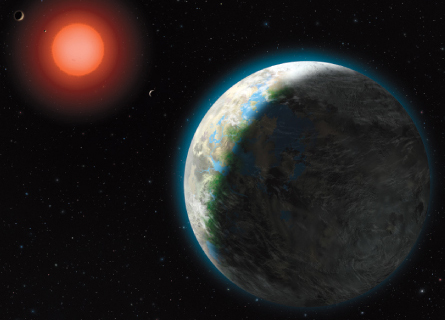Extrasolar planets coming into focus
The discovery of a planet orbiting a dim dwarf star about 20 light-years from Earth has encouraged astronomers in their hunt for habitable, and maybe even inhabited, worlds elsewhere in the galaxy (SN: 10/23/10, p. 5). Though some researchers question the finding (SN: 11/6/10, p. 14), astronomers suspect that dozens of potentially habitable worlds will be discovered as the number of known exoplanets continues to climb.
The Kepler spacecraft, which monitors some 156,000 stars for dips in starlight that indicate the passage of planets, had found a whopping 706 candidate bodies by June, bringing the total of presumed extrasolar worlds to well over 1,000. One of Kepler’s discoveries, though much too close to its parent star to support life, has a diameter only about twice that of Earth (SN: 7/3/10, p. 11). The finding demonstrates Kepler’s potential for finding Earth-sized planets.

Astronomers have also found evidence for planets originating outside the galaxy (SN: 12/18/10, p. 11), in the form of a Jupiter-sized body orbiting the star HIP 13044. The star is thought to have been hurled into the Milky Way after being ripped from a satellite galaxy billions of years ago.
Tiny martians Tiny fossils discovered in sulfate minerals on Earth suggest that similar remnants of life might be found on the Red Planet (SN Online: 4/29/10).
Second look Martian soil could contain the building blocks of carbon-based life after all, despite the negative results of an analysis performed by the Viking missions (Viking 1 shown below) more than three decades ago (SN: 10/9/10, p. 9).
Dark glimmers An excess of gamma rays emanating from the galaxy’s center may indicate the presence of dark matter, an exotic material that has never been observed but must exist to keep galaxies and galaxy clusters from flying apart (SN: 11/20/10, p. 11).
Galaxies far, far away Astronomers identify galaxies that may be the most distant starlit bodies known, each lying 13.2 billion light-years from Earth (SN: 1/30/10, p. 5).
LHC revs up The Large Hadron Collider sets a record for the highest-energy collision of subatomic particles (SN: 4/24/10, p. 10).
Flushing out the Higgs The elusive Higgs, a proposed subatomic particle that would explain the origin of mass, has fewer places to hide, two experiments reveal (SN: 8/14/10, p. 16).
Early light dawns The Planck spacecraft obtains the sharpest view yet of the early universe (shown above), while an older craft looking just as far back in time refines the age of the cosmos (SN: 7/31/10, p. 15; SN: 2/27/10, p. 7).
Big star Astronomers have discovered the heaviest known star, which tips the scales at about 265 times the sun’s mass and at birth weighed more than twice the generally accepted limit for a newborn (SN: 8/14/10, p. 16).
Sky-high life Simulations of Saturn’s moon Titan suggest that the ingredients for life, such as the building blocks of DNA and RNA, may have formed in the atmospheres of planets and moons without the presence of liquid water (SN: 11/6/10, p. 15).
Heads-up Fluctuating bursts of microwave energy from the sun could provide warning of the huge solar flares known as coronal mass ejections (SN: 8/28/10, p. 13).
Galaxy fell together A preliminary analysis of elderly stars suggests seemingly disparate chunks of the Milky Way formed at the same time from one blob of gas and dust, possibly striking a blow against the prevailing theory of galaxy formation (SN Online: 5/4/10).
Lying about its age A meteorite’s age has pushed back the estimated time of the solar system’s formation by almost 2 million years (SN Online: 8/23/10).
Radio silence With Earth — and perhaps other places in the galaxy — growing more radio silent, many researchers are rethinking the search for extraterrestrial life. But better radio telescopes (Allen Telescope Array below) are still in the works (SN: 4/24/10, p. 22).
Slow cycle Gas flows on the solar surface may explain why the sun recently had such a prolonged case of the doldrums, and could lead to more accurate predictions of the duration and severity of future solar cycles (SN: 4/10/10, p. 8).
Seltzer moon A fizzy ocean, similar in carbonation to Perrier, may feed the plumes of water vapor, gas and ice that erupt from the south pole of Saturn’s moon Enceladus, a new model suggests (SN: 11/6/10, p. 15).
Full of stars The abundance of red dwarfs in eight nearby galaxies suggests the stellar population of the universe may be three times current estimates (SN: 1/1/11, p. 10).
Milky Way bubbles Astronomers discover two giant blobs of gamma ray–emitting gas above and below the galaxy’s center, probably produced by the supermassive black hole presumed to lurk there (SN: 12/4/10, p. 18).




